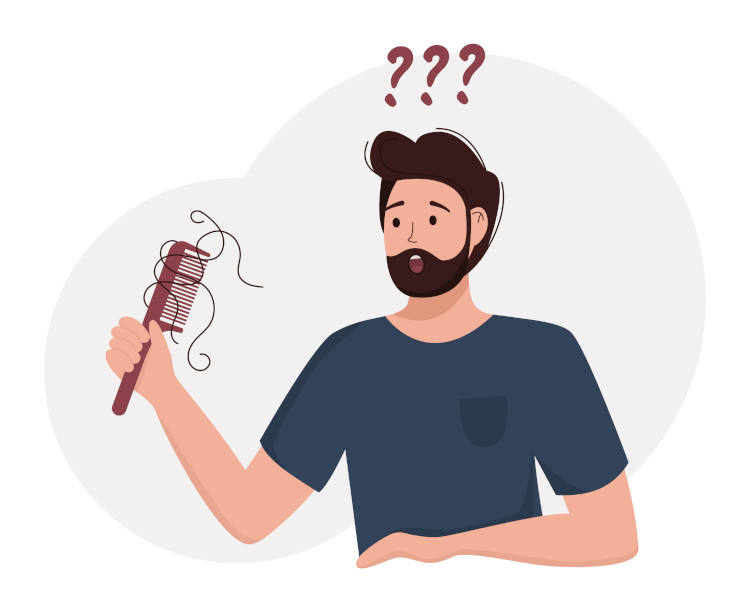
Your Guide to Hair Loss Causes and Treatments
While hair loss is more prevalent in older adults and men, it can affect anyone at any age. There can be many reasons for alopecia including genetics, changes in hormones, medical conditions or just as a part of ageing. Certain kinds of hair loss are in response to a fungal infection or due to a stressful event.
Understanding the cause of your hair loss is important to determining the best course of treatment. Learn about its different types and how to effectively combat them.
Summary
- How Do I Know If My Hair Loss is Normal?
- How to Identify and Treat Hair Loss?
- How Can Elithair Help Me Fight My Hair Loss?
How Do I Know If My Hair Loss is Normal?
On average people lose around 50-100 hairs a day which may sound like a lot but these individual strands make up the 100,000 hairs on your scalp. When it comes to your appearance, hair loss isn’t that noticeable on a daily basis. Hair growth happens as part of a cycle meaning that there are constantly new hairs appearing to replace those that have been lost.
Different types of hair loss
While it may seem obvious that the loss of hair in larger quantities is the main symptom of hair loss, there are several different signs of alopecia which can be more difficult to spot. For example with telogen effluvium, hair falls out following a shock to the system. Or your parting can be seen to widen which can lead to the hair thinning.
Different types of hair loss manifest in different ways. Such as a receding hairline which is when the hairline appears higher than usual while bald patches can be seen in varying sizes and can even grow over time. There can be visual indicators as well outside of checking your scalp. You should look for an excess of loose hair in your brush or check your drain to see if its being clogged with hair.
How to Identify and Treat Hair Loss?

There are many different causes for hair loss and it’s important to identify them in order to find the best solution. The list below will help you differentiate between all the most common baldness issues.
Androgenetic Alopecia
Causes
This type of alopecia also known as hereditary hair loss is the most common cause of hair falling out. Often referred to as female/male pattern baldness, the process typically happens gradually over time usually beginning around puberty.
In men androgenetic alopecia presents as an “M” shape starting above the temples and then the hair at the crown tends to thin. Whereas with female pattern baldness the hair recedes along the parting and there can be thinning all over the head. While losing your hair is a normal part of the ageing process if it occurs prematurely you may have hereditary hair loss.
Genetics
If you look at your family history and there is a prevalence of alopecia in your parents and grandparents generations then it is likely you will also suffer from hereditary hair loss as well.
Your genetic makeup can influence the age at which hair loss starts, how fast the hair is lost as well as the pattern and extent of the alopecia. While hereditary pattern baldness results in permanent hair loss and will not regrow there are still solutions to slow it down or treat it depending on the severity.
Treatments
In terms of treatments, there are topical and oral medications that can be taken which have been shown to provide results in helping to prevent hair loss from progressing further. However they need to be taken daily in order to keep up the hair growth and both are known to have negative side effects.
For a long lasting solution, hair transplantation takes healthy hair follicles from the back of your head and implants them onto the affected areas. It is generally a one time procedure that allows you to enjoy thick, full hair for life.
Alopecia Areata
Causes
With alopecia areata, the cause for the hair loss is the immune system attacking the hair follicles on your head. This can then cause bald patches to form and can result in complete baldness which is known as alopecia universalis.
After the hair has fallen out it can grow back only to fall out again, creating a cycle which is unique to each person. The condition can not only affect head hair but also eyebrows, eyelashes and hair on other parts of the body.
Alopecia areata is known to be associated with other medical conditions that are classed as autoimmune disorders such as vitiligo, atopic dermatitis and hypothyroidism among others according to the American Academy of Dermatology.
Treatments
Depending on the severity of the hair loss there are different treatment options available to those suffering from the autoimmune condition. Certain steroid injections can be implemented to aid hair regrowth on affected bald spots but the procedure needs to be done every 1-2 months.
There are also oral immunosuppressants which stop the immune system’s response to damage the hair follicles. However they cannot be used on a long term basis due to potential high risk side effects such as high blood pressure and lymphoma. A hair transplant may also be performed on those who have not had long standing alopecia areata in consultation with a hair transplant specialist.
Traction Alopecia
Causes
Alopecia can also be caused by the hair being pulled into a tight hairstyle. This is often seen in those who wear their hair in a tight bun or ponytail, braids and extensions. Once it develops, traction alopecia can cause bald spots and hair thinning. The scalp hairs can become particularly sensitive here due to the tension placed on them.
Treatments
There are easily actionable treatments for traction alopecia such as loosening the hairstyle or cutting long hair. There are also biotin supplements that can help enrich the hair with crucial nutrients for hair growth.
Hair transplantation can aid in permanently resolving the hair loss issue by promoting hair growth in the affected regions using healthy follicles.
How Can Elithair Help Me Fight My Hair Loss?
If you’re concerned about your hair loss we can help you determine the best course of action. Using our patented Elit Skala our experts can assess the extent of your hair loss and recommend the most appropriate technique for your individual hair transplantation.
Receiving a hair transplant is the only permanent solution to combating baldness issues. We are on hand to provide you with the best results using cutting edge technology in our state-of-the-art clinic.



